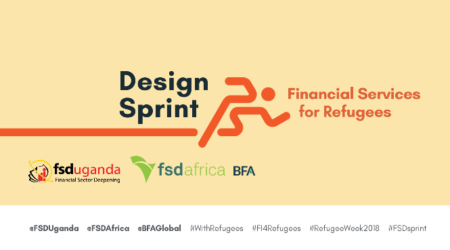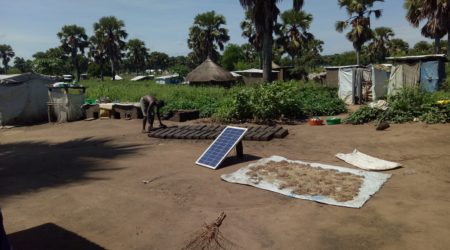Mapping the financial-access journey of the refugee: Applying UX design to help financial service providers in Uganda better serve forcibly displaced people
In April 2018, BFA Global facilitated a series of workshops for six banks – Diamond Trust Bank, Equity Bank, FINCA, Opportunity International, Post Bank, Ugafode – and a mobile network operator – Africell, in partnership with FSD Uganda. We shared research and statistics about the over 1.3 million forcibly displaced people (FDPs) living in the country, based on recent UNHCR data. And we invited the participants to imagine their life not as an employee of a large financial service provider (FSP) in Uganda, but rather to imagine their life as if they were a forcibly displaced person. “Step into the shoes of a refugee,” we instructed them:
Imagine you are Pierre. You came from the Congo 10 years ago and live in Nakivale camp. You’re a hardworking shop owner and it supports your family, but you’re looking for a loan to expand your business. Yet the nearest bank branch is 10 km away. And you have an expired ID.
Imagine you are Valarie. Originally from Burundi, 8 years later you run a fabric and hair business in Kampala. You want to open a physical store and expand to sell in neighboring countries. You’ve been a consistent savings-group member but need more capital. Yet when you’ve gone to banks for a business loan you’ve been denied not once but four times.
These are two of the refugee personas that BFA Global shared to bring to life the everyday activities, aspirations, and struggles of FDPs. In our workshops, these insights helped providers address key questions, debunk myths, and begin to think of refugees not as problems or edge cases, but as new valued customers.

From insights to ideas: journey mapping
Building on this foundation of awareness, how might we help FSPs apply these learnings to improve their offerings and better serve refugees? Some of their staff had already visited the camps and many were passionate about both the social and business impact they could achieve with this new customer segment. Yet many questions and challenges remained in bridging the gap between insights and ideas for action.
To address this, BFA facilitated a Journey Mapping exercise. Also referred to as Experience Mapping, it is a Human-Centered Design method that visualizes and synthesizes a person’s experience of a product, service, or business to communicate insights and takeaways, as well as guide areas for improvement and action. BFA’s journey-mapping exercise was based on its extensive experience in service/UX design and utilized a library of resources shared by social impact design firm AdaptivePath.org.

As a method, journey mapping allows users to understand a product/service experience from the perspective of the refugee and to assess the product holistically across channels. By understanding the conditions, capabilities, needs, and motivations of the refugee customer, we can imagine how they may first discover a product/service, what types of interactions and channels are relevant to them, at what point the customer realizes benefit from the service, and when the customer adheres to a new behavior and is converted to a service over a longer term.
In our workshops, each FSP team selected a refugee persona, e.g., Pierre, Valarie, Ayak, or Mary. They then identified a goal of their refugee, such as expanding their business or saving for higher education. This helped them define the journey the refugee needed to travel to achieve their goal, ranging from talking to friends and family about recommended financial products to approaching an FSP, i.e., a bank or mobile-money operator. We then mapped the building blocks of the refugee experience, which included:
- Doing: What actions do refugees take to meet their needs? What are their key behaviors?
- Thinking: How do refugees frame and evaluate their experience? What are their expectations?
- Feeling: What emotions do refugees have along their journey? What are the high points of the experience? The low points?
- In addition, what channels are relevant to refugees, i.e., are they best reached through radio, print, word of mouth, Whatsapp, social media, and what are the key touchpoints of interaction, e.g., an agent, when receiving a disbursement or remittance, at a settlement service point, etc.?
The FSP participants looked at each building block and mapped them over time in a highly detailed process. After identifying the different building blocks and looking at them all together, it formed a powerful picture of the refugee’s experience through the refugee’s eyes. This enabled us to take each step in the shoes of Valarie or Ayak or Pierre. As we did so, we uncovered pain points that may have seemed small from the perspective of a financial service provider. But with greater empathy for the refugee, we could see how they quickly become demoralizing impasses and drop-off points for someone who had been forcibly displaced. For example, trust was a major theme that came up. Fears and negative experiences with banks for some refugees may mean they will not trust a new FSP. How could we ensure that refugees feel comfortable, welcome, and supported as they sign up for and begin to actively use a new provider’s products? How could we ensure that a provider’s agents and staff can speak to refugees in their native languages to maximize accessibility and build more trusted relationships? How could a provider increase their touchpoints and networks so refugees in remote settlement areas don’t have to walk 10 km when they have a question or a problem?
As a finishing touch, the teams drew an emotion line or “mood meter” for the refugee’s journey, based on the building blocks they had mapped. They then chose the lowest emotional point in the journey to see how they might address the challenges embedded there. Each team came up with a range of ideas to solve the problems the refugee was facing there as well as at other pain points, including new types of awareness campaigns to offering financial literacy to getting mobile phones into the hands of FDPs in order to facilitate mobile banking.

Nine (9) journey maps later… what did we learn?
As we stepped through the Journey Mapping exercise, we saw each team become excited about the refugee personas they were getting to know, realizing how refugees could be potential customers, and in some cases seeing some as agents they should recruit. These seven FSP teams learned to see the refugee experience through a different lens, a customer-centered point of view, and to see them as human beings with needs and aspirations:
Before when I went to the [FDP] camp, all I thought about were getting deposits. Now, I think about solutions for their problems that also generate revenue.
Now I don’t see cash transfer payment requests as statistics, they are actual people.
Our intention was—without leaving Kampala—to encourage FSPs to walk the journey of the refugee, along with them, to better understand who they are, see the potential business opportunity, gain empathy for their lives and struggles, and to lay a foundation for a relationship based on trust and value. When FSDU shared its roadmap of interventions to serve FDPs in Uganda, each of the seven providers expressed interest and excitement, including visiting refugee settlements to continue the learning process and to further advance their development of refugee-centered financial services.



